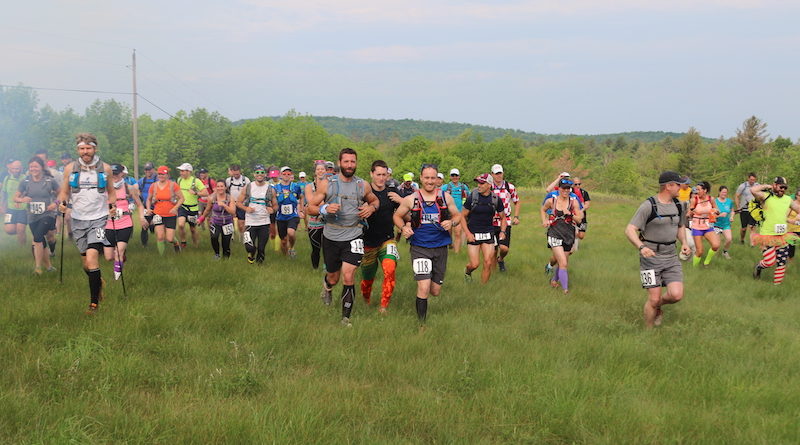The Endurance Society wants (to break) you
The following is the story of the 2015 Infinitus.
On June 21, somewhere in Addison County in a mountainous stretch of private forest, a few dozen ultra athletes will begin a weekend in hell.
Truth is, that’s about all we can tell you: the event has been kept secret. In fact, the only thing the contestants knew when they signed up was the race’s name: Sine Nomine (Latin for ‘No Name’).
The website posted no registration information: no distances, no details, no location. When it first launched a few years ago, there was just an eerily disturbing video reel showing vintage black and white clips of kids on a carousel, soldiers marching backwards, Albert Einstein, body builders and more. The voiceovers start with an ominous Latin intonation. The reel ends with Winston Churchill’s famous speech, “The only thing we have to fear is fear itself.”
And then a black and white shot of race organizers Andy Weinberg and Jack Cary dressed in period clothing.
Weinberg and Cary have been determined to keep the details under wraps.
“The original idea was we were going to have this secret society of endurance athletes,” Cary says. They created a logo (a crawling skeleton with a drawn sabre), and chose a motto: Sodalitas perdurantium. Robur corporis fortitudo menti,” Latin for “Society of those who endure. Physical strength, mental fortitude.”
Almost instantaneously, Sine Nomine sold out, with people submitting detailed resumes of their experience to qualify for one of the 50 spots. “We have ultra athletes, Green Berets, Navy Seals, you name it,” says Weinberg.
Ultra athletes themselves, both Weinberg and Cary have a cheery, if twisted, sense of humor and an uncanny ability to make you think, “Hey, this amount of pain could be fun.” As 888k-contestant Will Bradley put it: “Andy is this lovingly sadistic jerk. You can be having a really bad day, but he makes you laugh and gets you motivated to go out and do another lap. ”
Weinberg helped Joe De Sena found the now legendary Pittsfield Death Race and its more plebian offshoot, the Spartan Race. Cary ran what he calls “psychological operations” for those events, dreaming up things like a 26-question math and history test given to sleep-deprived contestants who had just summited a mountain carrying an 80-pound pack of concrete. “I’ve raced in the Death Race and other ultra events and I’ve quit. I know what it takes to break me,” says Cary. “These events are all about trying to push your limits.”
Since parting ways with De Sena (and getting embroiled in lawsuits and counter lawsuits) Weinberg and Cary have launched their own endurance events. In the winter of 2014-2015, they hosted Frigus, a series of cross-country snowshoe/sledding/ski races. And this weekend, they will hold the Infinitus, an 888-kilometer, 10-day trail run.
That one we can tell you about.
The fun started on Thursday, May 23 at 8:08 a.m. when 10 endurance athletes from around the country loped off to run for 10 days or 888 kilometers (whichever comes first) on rocky trails over the mountains and through the bogs of the Moosamaloo Wilderness in central Vermont. For anyone who’s not good at math, that’s 551 miles in 10 days—or more than two marathons a day.
In past years, over the course of a week, the racers have faced frost and snow on the trail, sleet, rain and, even worse: temperatures soaring into the high 80s. During a thunderstorm in 2015, one of the rivers racers had to cross rose chest-high. The runners encountered bear, moose, porcupines, snakes and one of the worst mosquito hatches of the past decade.
“The bugs are vicious,” says John Sharp, a muscular Texan as he ran into race headquarters at Blueberry Hill Inn’s cross-country ski center in Goshen one evening. He sprayed himself with mosquito repellant, wolfed down macaroni and cheese and guzzled a PBR before heading back out.
Several other racers were also taking break that evening around dusk. Jessica Pendleton, 37, an insurance executive from Iowa, looked exhausted as she propped her feet up so fellow competitor Joel Gat could tape her blisters. Eight days into the event, she was in second place, having completed 463 miles, sleeping only a few hours a night.
A mother of two she ran her first marathon 11 years ago. “I started running to lose weight after I was pregnant,” she said. “I did a couple of marathons, just walking and running at first, then a 50, then a 100. What I like about doing this is that it’s just you and running in the woods for a few days.”
Gat, a brewer from Arizona, warmed up for his 888k-run up by doing a 100-mile race two weeks before. But that race had a wicked twist: “You had to run a mile, then chug a beer, then run a mile and chug another, and I got drunk after 27 miles and had to drop out,” he said with a big grin.
Nearly half the racers paused at some point each day to eat, sleep and catch up with their fellow racers.
“The worst part is always my feet,” said Rebecca Hansen, a 53-year-old pre-med student from Naples, Fl., who brought bags of bandages and salve. Hansen has competed in the infamous Death Race in Pittsfield, Vt., Weinberg and Cary’s fledgling Frigus Race last winter (the 60K snowshoe race, held in sub-zero temperatures, was aborted midway) and a quadruple Ironman tri (that’s four times the regular distance of a 2.5 mile swim, 112 mile bike and a 26.2 mile run).
New Hampshire bike shop employee Kale Poland, who has completed a deca-Ironman (that’s 10 times the Ironman distance), was a favorite going into the Infinitus, but had to quit after 50 hours when his leg swelled up with gout.
In the end, the winner, and only person to complete the full 888K, was Greg Salveson, a 28-year-old graduate student from Boulder, Colorado, who by way of preparation ran a 100-mile race every month in 2014. With his father as his support crew and an RV as his personal race headquarters, he slept fairly well. “I made sure I ate every 15 minutes and consumed about 8,000 calories a day,” he estimates. His secret fuel: Snickers bars (“I ate about 40, and drank 16 bottles of Ensure to get the vitamins I needed. ” He finished at 4:00 a.m. on Day 9.
His prize: a medal, a belt buckle with the Endurance Society logo, and a bottle of maple syrup.
The 10 contestants in Infinitus paid upward of $479 (the early registration fee) to participate. Most of them rolled out Thermarests on the upstairs floor to serve as a make shift bed, and stopped only to grab a bowl of rice and beans or whatever else the organizers prepared each evening. Only one stayed at the inn.
“It’s the perfect marriage — a fine country inn and adventure racing,” says Blueberry Hill Inn’s owner Tony Clark, his British accent betraying a sense of irony. The area, with more than 60 miles of trails, has played host to numerous cross-country ski races before it cut back on its trail grooming operations a couple years back. Now trail racing (and backcountry skiing in winter) is helping it make a comeback as a sporting center.
On Thursday, May 23, racers embarked on the Deca-Marathon—running ten marathons in ten days. On Tuesday, May 28, another group took off for a 250-mile trail race, and on Friday, May 31, racers embarked on a 100-mile race. On Saturday, Weinberg and Cary kick off an 88K trail race and, at the same time, a rather pedestrian, by comparison, 8K race on area trails. All the races began at 8:08. All told, Weinberg and Cary attracted close to 200 Endurance Society members to participate in 2015.
For these events, says Weinberg, “we wanted to capture the ‘fun’ of endurance racing without the commercialism that has become associated with many of them. These events are totally different from Spartan Races or Tough Mudders—there are no obstacles, it’s just trail running and testing your endurance.”
Cary adds, “We intentionally wanted to keep them small, and even secret. But then we realized we also needed to get participants here so we couldn’t be too secretive. ” The pair also hope to put on ultra swimming events, and, perhaps a gravel bike race.
Part of the challenge of these Endurance Society events, Weinberg says, is the mental aspect, which is where Cary comes in. “These races tell you how far you can push yourself without breaking. I’ve been at that breaking point and I know how your mind can start to fail you before your body does.”
To spook some of the runners, Cary placed odd objects around the trails at night. A doll’s tea party might suddenly appear around the corner. A life size clown moved around the course. Masks and the number 888 randomly appeared in various segments of the course.
“After a few days of running your mind starts to wander and it’s easy to become disoriented at night on the trails,” notes Cary, whose day job is as a software engineer in Winooski. In fact, several racers went off course during the 888K and were temporarily lost. After that, the organizers refused to let anyone run solo after dark. Safety, after all, noted Weinberg, is essential. “We want to push people, not do them in.”
“The great thing about this event is that’s its not really a race against anyone but yourself,” said Salveson, after finishing. “I’ve had a pretty easy life, growing up middle class, going to grad school. This is one thing I can do that is really hard. In the end, it doesn’t matter if you run 500 or 400, we’re all out here rooting for each other and helping each other go as far as each of us can.”
At the start of the 10th day, Will Bradley was in last place and was pretty sure he was done. The least experienced of the group, his knees were sore and he was exhausted. He’d completed more than 270 miles, the most he’d ever run. He disappeared upstairs in the center, presumably to sleep. But then, after a 20 minutes, he was back down again, dressed in his race gear; water pack, hiking poles, and trail shoes.
“Anyone for another lap?” he called out.
Last updated May 29, 2019.



